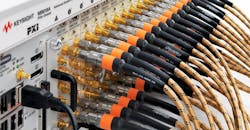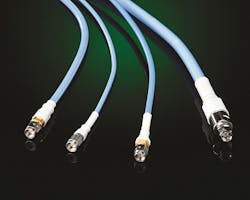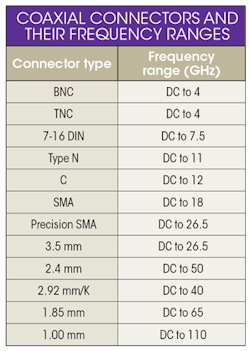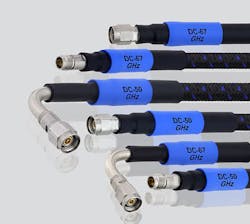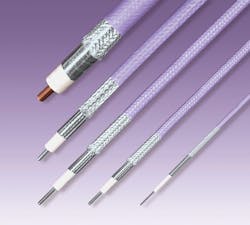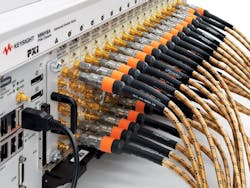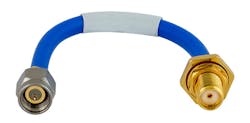Download this article in PDF format.
They are often the forgotten part of a system, the means of moving a signal from one point to another. With the fascination toward wireless applications taking center stage over the past three decades, RF/microwave engineers will tend to forget about the still-important needs for wires (cables) and connectors. They come in handy when interconnecting coaxial modules within a system or making a hookup between a device under test (DUT) and a test instrument, such as a spectrum analyzer or vector network analyzer (VNA).
Coaxial cables and connectors have come a long way from the basic assemblies that spanned dc to 18 GHz for military electronic-warfare (EW) systems and test applications. With the growing interest in millimeter-wave frequencies, a greater number of connector and cable suppliers are offering these parts and assemblies through 40 GHz. In fact, a surprising number offer cable assemblies that exceed 100 GHz. That’s in response to the availability of millimeter-wave test instruments and the need for testing higher-frequency DUTs for the anticipated greater use of millimeter-wave frequencies in emerging 5G wireless networks.
Frequency and Bandwidth
The dimensions of connectors and cables necessarily shrink with increasing frequencies to accommodate the smaller wavelengths at those higher frequencies. Government organizations such as the Small Business Innovative Research (SBIR) program are well aware of how bandwidth is being rapidly consumed at microwave frequencies, in both commercial and military systems, and all available bandwidth lies at higher frequencies. The SBIR is currently looking for microfabricated broadband connector designs through 400 GHz for millimeter-wave and submillimeter-wave applications (working in particular with Nuvotronics) in support of test and research work.
In the real world, however, available connectors and cables are typically much lower in frequency, although typical cutoff frequencies for the cables now reach into the millimeter-wave region. Many of the cable assemblies to 100 GHz and higher are marketed as VNA cables because they are mostly used for high-frequency coaxial measurements with a VNA.
As test and system engineers working with such high-frequency cables have learned, the flexible versions of such cables can be susceptible to phase variations with flexure. As is known by anyone who has watched the phase response on a VNA screen while inadvertently (or intentionally) moving the position of a test cable, the phase can change with such cable movement. A cable assembly’s amplitude characteristics can also change with time and temperature, which has led a growing number of cable manufacturers to develop “phase-stable” cables and cable assemblies.
Going Through a Phase
For example, Times Microwave Systems refers to its PhaseTrack cables (Fig. 1) as being “phase critical,” and has developed a proprietary dielectric material called TF4 to maintain excellent phase stability with frequency and temperature. The dielectric material was formulated as an enhancement over the polytetrafluoroethylene (PTFE) dielectric material commonly used in microwave cables, but characterized by a “phase knee” or phase transition at room temperature, indicating rapid changes in phase behavior of a PTFE-based cable.
1. These phase-stable cables employ a proprietary dielectric material to achieve phase stability with temperature. (Courtesy of Times Microwave Systems)
These 50-Ω phase-critical cables are available with different diameters; the smallest-diameter cables provide the highest frequency of operation, a cutoff frequency (Fco) of 80 GHz for the raw cable. When supplied as a cable assembly, the frequency cutoff will depend on the choice of connectors (see the table), with 1.0-mm connectors required for the highest frequency of operation.
The cables are constructed of silver-plated, copper-clad steel center conductor with silver-plated, copper-strip braid outer conductor and blue FEP jacket. They achieve phase tracking of 50 ppm with shielding properties of −90 dBc/ft. The cable loss is 64 dB/100 ft. at 6 GHz and 121 dB/100 ft. at 18 GHz, with a usable temperature range of −55 to +150ºC.
2. These VNA test cables are rated for as many as 100,000 flexures without significant degradation in performance. (Courtesy of Pasternack Enterprises)
Many of these VNA-type cables are characterized in terms of their phase variations with flexure, since flexible cables can commonly be moved and repositioned when connecting and unconnecting a DUT to a test setup. Flexible VNA test cables from Pasternack Enterprises are available with cutoff frequencies of 50 and 67 GHz (Fig. 2). They have maximum phase variation with flexure of ±6 deg. to 50 GHz and ±8 deg. to 67 GHz. The cables are rated for as many as 100,000 flexing cycles without significant degradation in performance, while the connectors can handle as many as 5000 mating cycles.
When higher-frequency operation is needed, Phase3 coaxial cables from MegaPhase with minimum diameter and 1.0-mm connectors (model CO5) are capable of low-loss operation to 110 GHz (Fig. 3). The cables are constructed with solid-gold-plated, copper-clad steel inner conductor; gold-plated, copper braid outer conductor; laminated PTFE dielectric; and blue polyolefin over FEP jacket. While the loss is 4.947 dB/ft. at 110 GHz, it is only 2.068 dB/ft. at 26.5 GHz, and just 0.347 dB/ft. at 1 GHz. The cable assemblies feature outstanding shielding effectiveness (SE) of −110 dB.
3. When equipped with 1.0-mm connectors, these high-performance cables can operate with 110 GHz with low loss. (Courtesy of MegaPhase)
Phase stability was one of the design goals of the Stability line of RF/microwave cable assemblies from Maury Microwave (Fig. 4). These phase- and amplitude-stable cable assemblies, designed for measurement applications, provide excellent repeatability even after multiple flexures. The cables use the ColorConnect color-coding scheme to identify cable and connector types to avoid improper mating and damage to connectors. The cable assemblies are available with a wide range of connectors, including 2.4-mm and 1.85-mm connectors for use to top frequencies of 50 and 67 GHz, respectively. The cables are also available in phase-matched sets for critical multichannel measurements, with phase matching within ±0.63 deg./GHz for two or more matched cable assemblies.
4. This test setup shows the arrangement of Stability phase-stable connectors used with a 32-port network analyzer. (Courtesy of Maury Microwave Corp. and Keysight Technologies)
At Lower Frequencies
Of course, not all interconnect applications are in the millimeter-wave frequency range. For many applications, a standard microwave cable assembly will do the job. Mini-Circuits recently added a line of 4-in.-long flexible coaxial cable assemblies for interconnections in tight places (Fig. 5). The 141-SMSM+ series Hand-Flex flexible coaxial cables have an SMA female bulkhead connector at one end and an SMA male connector at the other end. The configuration eliminates the need for bulkhead adapters, and the minimum bend radius of 8 mm simplifies interconnection of even closely spaced components. The insertion loss is typically 0.05 dB from dc to 2 GHz and no more than 0.21 dB from 2 to 18 GHz.
5. These short, flexible cable assemblies are designed to make interconnections in tight spaces. (Courtesy of Mini-Circuits)
One of the latest connector developments intended to simplify assembly of printed-circuit boards (PCBs) is a solderless end-launch connector from SV Microwave. It mounts by means of compression fit and provides the transition from the coaxial signal realm to a PCB using the most popular transmission-line technologies, including microstrip, stripline, and coplanar waveguide (CPW).
The connector, which is fabricated with stainless steel, adjusts to multiple thicknesses of PCBs. It comes in a number of connector configurations, including SMA, 2.92-mm, 2.4-mm, and 1.85-mm types for high-speed digital applications as well as analog frequencies from dc to 50 GHz. Versions are also available for screw mounting.
About the Author
Jack Browne
Technical Contributor
Jack Browne, Technical Contributor, has worked in technical publishing for over 30 years. He managed the content and production of three technical journals while at the American Institute of Physics, including Medical Physics and the Journal of Vacuum Science & Technology. He has been a Publisher and Editor for Penton Media, started the firm’s Wireless Symposium & Exhibition trade show in 1993, and currently serves as Technical Contributor for that company's Microwaves & RF magazine. Browne, who holds a BS in Mathematics from City College of New York and BA degrees in English and Philosophy from Fordham University, is a member of the IEEE.
